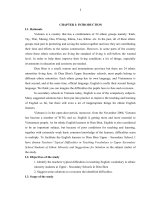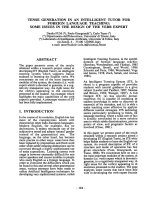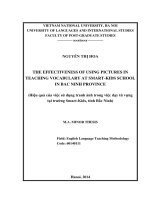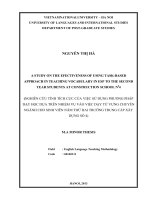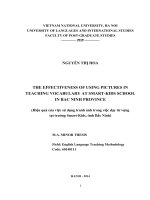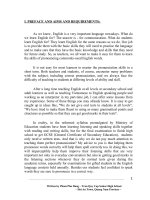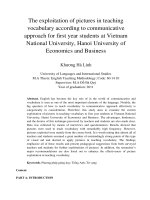Some experiences in teaching vocabulary of comprehensive level
Bạn đang xem bản rút gọn của tài liệu. Xem và tải ngay bản đầy đủ của tài liệu tại đây (455.2 KB, 18 trang )
THANH HOA DEPARTMENT OF EDUCATION AND TRAINING
NGUYEN MONG TUAN COMPREHENSIVE SCHOOL
EXPERIENCED INITIATIVE
SUBJECT:
SOME EXPERIENCES IN TEACHING
VOCABULARY OF COMPREHENSIVE LEVEL
Writer : Ha thi Thanh Tam
School’s post : Teacher
School: Nguyen Mong Tuan comprehensive school
Experienced initiative of subject: English
THANH HOA, 2016
TABLE OF CONTENTS
1. INTRODUCTION
page 1
2. CONTENTS
page 2
2.1. Introducing Vocabulary
page 2
2.2. Practicing Vocabulary
page 9
2.3. Vocabulary Games
page 12
3. CONCLUSION
page 13
REFERENCES
page 15
2
1. INTRODUCTION
English was already well on its way to become a genuine lingua franca at
the end of the twentieth century, that is a language used widely for
communication among people who do not share the same first or even second
language. English is also a mother tongue for many people in the world, though,
as we will see, such ‘native speakers’ are growingly out - numbered by people
who have English as a second or third language and use it for international
communication.
It is clear that English is special and it is challenged by the many different
shifted dramatically, as the numbers quoted above will have demonstrated. All
of these issues have a bearing on how and why English is taught. These issues
are big problems. But in this paper I only mention my some experiences in
teaching vocabulary that I have approached from my Diploma in TESOL
Course to teach my students in Nguyen Mong Tuan Comprehensive School.
1
2. CONTENTS
We saw some of the many ways we can explain meaning, and when
teaching vocabulary this is a major part of the teacher’s art. Students need to see
words in contexts to see how they are used. As for me, the best way of
introducing new words is for students to read texts or listen to audio tracks and
see or hear those words in action.
A major reason for reading texts in class is to give students new language
input. And whenever teachers ask students to read or listen, the teachers will
want them to see how words are used. That is why when students read texts, the
teachers will have them to do exercises such as matching words form texts with
their definitions, or asking them to find a word in a text. The teachers may get
the students to say what a word means, or ask them which word in the text is the
opposite of given word, etc.
However, at other times we set out teaching or practicing a specific aspect
of vocabulary, and the examples in the paper showing some ways in which can
be done. I want to introduce some my activities designed to have students to
research words for themselves using reference.
2.1. INTRODUCING VOCABULARY.
When the teachers introduce new vocabulary, there is always a chance, of
course, and it is not new to some students in the class. That is because elicitation
is so important. By the time students get to upper intermediate level or beyond,
the teachers can be sure that some of them will know some of words and ask
them to focus on. Examples below are clearly designed to focus the students’
attention on an area of vocabulary.
Example 1: WALKING, RUNNING, JUMPING (Focus: Verbs of movement)
The teacher starts by showing or drawing pictures, or miming the actions in the
table 1. The words are carefully modeled, and the teacher may well conduct a
rapid cue-response drill where she points to a picture or mimes the action and
then give tasks to students to say walk, run, jump, etc.
Vocabulary
Walk
Run
Jump
ride a bike
Fly
Pictures
2
( Table1)
Now, the students are asked to put the correct verbs in the sentences in
table 2. These can be projected or written onto the board, provided that the
students can still see the pictures. This can be done with the whole class or in
pairs. If the students have worked on the exercise in pairs, the teacher goes
through the answer, making sure that the students pronounce the words
correctly.
Complete the sentences.
1.
He…very fast.
2.
The girl…to school.
3.
The bird … in the sky.
4.
He…a bike every day.
5.
The girl…too high.
(Table 2)
Finally, the students can be asked to write new instructions using the new
words, as in table 3
Write instructions for this fitness exercise.
Use words from the box.
1. Sit down
2. ….
3. stand…
4. …
5. climb…
6. …
7. run…
walk
run
stand
sit
up
down
on the box
off the box
lie
round the room
climb
jump
(Table 3)
Example 2: INVITING (Focus: Functional language)
The following sequence gets students to make invitations to accept or
refuse them. Like many lessons focusing on functional language, it concentrates
on lexical phrases or chunks. The students are shown a picture of a lake or a
river where people are rowing each other around. In the foreground, a woman is
talking to a young man with a broken arm. The teachers tell the students that
they should read the following dialogue and if they can guess the word or words
that are missing in each the blanks. (Table 4)
3
Peter: Hi, Mary.
Mary: Hi, Peter.
Peter: Would you like to (1)…rowing?
Mary: Rowing?
Peter: Yeah. Rowing. You know. In (2)…
Mary: (3)…it’s ‘in a boat’. It’s just that, well, you have a (4)…
Peter: You’re right! (5)… I thought you could (6) … the actual
rowing.
Mary: Oh no.
Peter: No? (7) …
Mary: I’m not (8) … rowing, actually. I’m not (9) … at it.
Peter: Oh… right. Well, how about a walk?
Mary: I’m a bit tired.
Peter: Or… a coffee?
Mary: Now you’re talking!
(Table 4)
When the students have compared their possible answer, they hear the
dialogue spoken on an audio track so that they can see if they were right. (The
answers are: go, a boat, Of course, broken arm. That’s why, do, Why not?
crazy about, very good). We can then get them to practice speaking the dialogue.
We can get the students to repeat the different some phrases both chorally or
individually.
Invitation phrase stems:
Do you fancy…
Do you want to …
How about …
Would you like to …
They now look at a list of phrases and have to decide whether they
mean that the speaker is saying yes, is not sure or is saying no.
4
Copy and complete the chart with the phrases.
I’d love to.
I’d like to but …
I’d rather not.
I’m not really sure.
No, thanks.
Perhaps.
That’s would be great.
What a fantastic idea!
Why not?
Yes, OK.
Yes, please.
Now you’re talking!
Saying Yes
Not sure
Saying no
The teachers will have the students say the phrases correctly, and to pay
attention to the intonation they use. The teachers help them to practice simple
invitation-reply exchanges by cueing them with words like house (How about
coming to my house? That would be great).
The students can write longer dialogues in pairs. While they are doing
this, the teachers can go around the classroom governing their progress and
helping them if necessary.
Finally, the students read out or act out their dialogues and the teachers
give them some feedback. It is worth to notice that the level of original dialogue
is somewhat higher than the language the students are being asked to produce.
That is why I think the students can deal with more language when they read
and listen than they can when they have to come out with it themselves. When
the teachers teach functional language like this, they almost always end up
getting the students to use phrases rather than individual words, it is because
certain common exchanges tend to use these pre-fabricated chunks (I’d love to,
I’d rather not, Would you like to…) as a matter of course.
Example 3:
EXPAINING WHAT YOU MEAN(Focus:Type, Kind, Something you use…)
Helping the students with vocabulary problems that they can use as they
do not know the words what are or to express things. The sequence begins when
the students talk to each other in pairs or groups and discuss situations in which
they need to explain things to visitors, family and friends, etc. They read some
descriptions and have to say or guess what is being described. (Table 5)
5
1. ‘It’s a type of sport which you do in the sea. You need a board and big
waves. It can be dangerous, but it’s really exciting.’
2. ‘It’s a kind of meal you get in Indian restaurant. It’s hot and spicy and
usually has meat in it. You eat it with rice.’
3. ‘It’s the stuff you find under grass. It’s brown. You see it when it rains.’
4. ‘It’s something you use for cleaning the house. It’s a machine that pick
up dust and small pieces of dirt.’
5. ‘They are usually made of wood. They are a useful thing to have in the
house, because you can put books on them.’
(Table 5: From Total English Intermediate by A Clare and J J Wilson – Pearson
Education Ltd)
The students can then check their answers with words written below. (surfing,
curry, mud/earth, vacuum cleaner/hoover, bookshelves) before discussing with
the teachers:
a) When the expression in bold are used (when we do not know a word for
something, or we want to explain the meaning of something).
b) Whether thing and stuff are used for countable nouns or uncountable
nouns.
The words and phrases have been introduced the students do a practice exercise
to help them get used to them. (See Table 6)
Put the words in order to make sentences. Then match the descriptions to
the pictures
1.
2.
3.
4.
It’s Spain kind a dish of from rice.
It’s a place where you can take a bus.
It’s a dish what we eat every day.
You can use it to talk with friends and send or receive messages from
them or you can listen to music or play games…
5. We usually give what to our friends on Valentine Day February 14.
6. It’s a place where we live with our family.
7. We go to this place to shop for everything.
6
(A)
(B)
(C)
(D)
( F)
(E)
( G)
(Table 6)
7
The next stage of the lesson sequence is for the students to compile lists
of things so that they can use these things in subsequent exercises. In groups,
they have to a) draw things which are rectangular, oval, round or square, b)
name animals that are enormous/huge, tiny, etc. and c) name things that are
rough, smooth, sticky, soft or hard. They can compare their choices with the
teachers.
The students are in a position to describe things for each other. They have
to do this by taking part in an information-gap activity where one student in each
pair has the crossword for student A and the other has the crossword for student
B. they take turns describing the words by explaining what they are rather than
naming them. (See Table 7: Information – gap crossword)
Student A:
1
3
2 r e c i p e
1 c a r d s
4
5
5
y
o
g
h
u
r
t
6
3
a
b
l
7
m I
l
k
d i
n
o
s
8
a u
r
9
7
4
e c
l
o
k
t
a
r
a t
e
6 k e
b
a
b
h
(Table 7-A)
Student B:
1
1
5
6
v
o
3
w
2
c
a
s
h
4
e
k
e
f
i
s
r
n
s
i
3
8
9
d
8
5
7
l
7
m
n
g
l
b
a
a
e
e
r
t
p
y
b
a
l
l
i
c
k
c
h
6 k
i
n
4
(Table 7-B)
If the students meet trouble remembering words, they can start to explain
themselves. These examples have followed a straightforward PPP or straight
arrows type progression.
2.2. PRACTICE VOCABULARY.
The aim of this activity is to ask students to use words that they know less
or more, but the teachers need get the students to think about word meaning in
context.
Example 1: WORD CIRCLE (Focus: Compound nouns )
The teachers draw a wheel of words and then say which words combine
with book and TV to make compound words. The teachers begin by presenting
students the wheel and help them can realize that while book + case =>
bookcase; or TV + case cannot work in the same way. (See Table 8)
9
(Table 8: Words circle form Have Fun with Vocabulary by A Barnes, J Thines
and J Welden – Penguin Books)
The students work in pairs or groups and do the combinations as fast as
possible, then the teachers go through the answers with class, the teachers can
show some of compound words on the board and have students to check with
their dictionaries to see if they are right. Besides that the teachers can ask the
students to use them in new sentences or let class play game Noughts and
Crosses squares or have students to choose any of three the compound words to
write a questionnaire to find out about people’s attitudes or habits worrying
BOOKS or TV.
Example 2: WORD MAP ( Focus: Houses, Rooms, Objects )
This activity is designed to engage students to set up vocabulary
knowledge as well as to provoke students into regaining and using what they
know.
The students will work aspects of houses and the things in them. The
teachers start by showing the beginnings of a map on the board. (See Table 9)
10
(Table 9: The word map stage 1)
After that the students go to the board and add some rooms to the map as
in Table 10. And the teachers can elicit words for one of the rooms. (See table
10B)
(Table 10A: Word map stage 2)
11
Gas stove
fridge
cooker
sink
Micro wave
oven
(Table 10B: Word map take shape - Stage 3)
Now, the teachers have students to work in groups and then allocate one
room per group and told the students as many as they can write to the word map
for their room. The teachers should let the students in competition with other
groups. The students can look for words in dictionaries while the teachers can go
around monitoring the students’ progress. If the students need some helps, the
teachers should be fair about how much help. The word map is complete, the
teachers can make sure the students say word correctly before get them to
describe their favorite room at home, or the teachers can give the students a
picture of an empty room and ask them to put what in it. The teachers sometimes
use the word maps to show how words group together. Having the students to
build up their own ways maps by working in groups has the advantage of
making them try to learn and remember many words they know.
2.3.VOCABULARY GAMES.
There are many games that are suitable for use collecting of vocabulary
items. Games are sometimes not only designed for language students but also
different student levels in our lessons. In this section, I want to introduce some
games that are designed to engage students.
Example 1: SNAP ( Focus: Word meaning )
12
When I have taught vocabulary, I have applied this game and my students
are involved the game and their vocabulary improved. The teachers should let
students play in pairs or groups. The game is useful for simple word-meaning
recognition. Two students have a pack of words. One pack has a picture and the
other has words that relate to the pictures. The students deal their cards and put
down each card. When a picture card (e.g. a picture of a house) matches the
word card (house) put down at the same time the first person to say SNAP! Keep
pairs of cards. The object of the game is to collect as many pairs as possible.
(See Table 11)
FRUIT
Check
(Table 11: Fruit matching game)
Example 2: BACK TO THE BOARD (Focus: Explaining word meaning)
In this game, students have to explain the meaning of a word or phrase to
other in their group so that she or he can guess what the word is. The teachers
should let students play in small groups. One student of in each group has to sits
with their back to the board. Then the teacher writes a words or phrase on the
board. All of the members in groups can see this word or phrase and they have
to explain what it means. (without saying the word or phrase itself) to the
student whose back to the board. The first student can guess the word or phrase
gets a mark for their group. The game is designed more formal in structure if the
students with their backs to the board and they have to get information from
their group by asking yes/no questions only, e.g. Can you find it in the
classroom? Is it more than one word?
Example 3: GOT IT
( Focus: Word enjoyment/ recognition )
The aim of this game is designed to engage students with a list of
vocabulary items. When I applied the game, my students had a good time doing
it because they can see and hear a range of words. The teacher should let the
students play in groups of four or five, all of them sitting around the table. The
teacher gives each group a collection of 15 – 20 words written on individual
13
pieces of paper. The pieces of paper face up on the table in front of the students,
and all students can see them. Then the teacher reads out words one by one. The
task of each student is try to snatch the piece of paper with the word on it, they
have to hole the paper up and shout GOT IT!
The game is a relaxing way of getting a class going. The words can be
used in many lessons/ topics, they can form the basis of a word map, and
students can be questioned to use them in conversation or writing
3. CONCLUSION
There are many ways to set up teaching or practicing vocabulary, and part
of the enjoyment of being a student in a good classroom is in sharing the
personal identity, style, skills and techniques that a teacher brings to a lesson. In
my opinion, teacher’s lessons are always entertainment, informative and
interesting. The teachers have to try involving the students actively and putting a
great deal of effort into finding appropriate and interesting activities that will do
in the classroom.
However, teaching vocabulary has not been still new one, I have
employed some ways in my teaching vocabulary process, because my students
are not good at English, they only learn English to communicate in their future
work, English is only a part of their all subjects, they have to try their best all
ones. This reason makes me to choose the suitable method to teach vocabulary
for them. I cannot start the lesson by giving them tasks, then ask them to work
in groups and finish by listening and taking notes to comment their writing at the
end of the lesson. As I have employed the teachers’ roles from my teaching
process, the teacher is not only a ‘organizer’, a ‘knower’ or a ‘counselor’, but
also the teacher as a ‘controller’, a ‘prompter’, a ‘participant’, a ‘tutor’, and an
‘observer’. As for me, the students play a vital role in the teaching and learning
process, this role is fulfilled in the classroom as the students are the centre of the
teaching and learning process. The teachers have to help students in their
studying in the classroom and after class as well, to guide them how to learn
beneficially, the teachers have to become awareness of their roles to their
students, when the students understand what and how they to do they will love
working in the classroom, and they realize their important studying they will
success in studying.
I personally think that to learn a foreign language well, learners have to
know the need and the value of learning, because language learning process is to
acquire knowledge and skills. So, learners can learn to improve their study and
learn to solve complex problems. Teachers should help learners to rise up and
success their language learning as well as help them enjoy and ready to learn.
Through the paper I have marked a key point in my teaching is that: all
students are different, so teaching vocabulary programs should be sensitive
14
and suitable to the differences. Moreover, a teacher is not only a guide, but
also as a participant or tutor during class and after class.
Above are just a few ideas small experience of myself, certainly will not
avoid errors or confusion. So I am looking forward to the suggestions of
colleagues to my initiative be applied more effectively in the next years.
I sincerely thank you!
CONFIRMATION OF THE PRINCIPLAL
Thanh hoa, May 10, 2016
I declare that this is my writing
and it does not infringe any copy
Written by
HA THI THANH TAM
REFERENCES;
Bell, M. (1996). Teaching vocabulary to EFL learners. Retrieved October 2,
2010
from />Gairns, R. and Redman, S. Working with Words (1986), CUP
Harmer, J. Practice of English Language Teaching (2001), Longman
McCathy, M. Vocabulary (1992), OUP
Morgan, J. and Rinvolucri, M. Vocabulary: Resource Book for Teachers (2004),
OUP
Miralpeix, I. (2006). Vocabulary acquisition in English as a foreign language.
Retrieved October 2, 2010 from />
15
16

